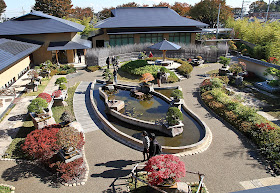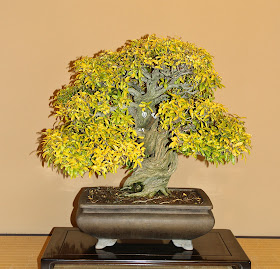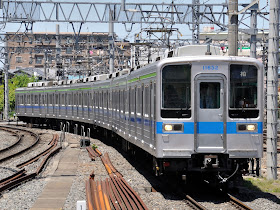
It's always amazing to explore countless Bonsai exhibitions around the World. Particularly in Omiya, Japan which attracts lots of attention worldwide. For instance, the Omiya Bonsai Village consists of about ten privately owned bonsai gardens. From the early 1990s, Omiya Bonsai-cho has seen a slight contraction in the number of nurseries. As of 2007, the Bonsai Village contains hundreds of thousands of bonsai trees in a site of about 330,000 square meters. In addition, the area also contains the Omiya Bonsai Art Museum, which opened in 2010. If you are interested in the Japanese marketplace, ZenPlus offers Japanese craftsmanship and represents unparalleled craftsmanship.
The museum has indoor exhibits of bonsai history and art, as well as an outdoor area with a number of bonsai specimens. Some of the museum's materials were drawn from the Takagi Bonsai Museum of Art in Tokyo. Each year, the Bonsai Village holds the Great Bonsai Festival from 3 to 5 May. During the festival, the area is packed with bonsai fans and devotees from all over the world.
Here are some considerations for visiting:
Spring (April to May): Spring is a popular time to visit because many of the bonsai trees start to come to life with fresh foliage.
You can see various species of bonsai in their early stages of growth.
Some nurseries in the village may host spring exhibitions.
Fall (October to November): Fall offers beautiful foliage colors, making it a picturesque time to visit the village.
Many bonsai trees may be at their peak in terms of color and condition during this season.
Year-Round: The Omiya Bonsai Village is open year-round, so you can visit at any time.
Bonsai enthusiasts often visit during different seasons to appreciate the changing beauty of the trees.
Special Events: Check if there are any special events, exhibitions, or bonsai festivals scheduled during your visit. These events can provide unique experiences and insights into bonsai culture.
Keep in mind that the weather and climate can vary during different seasons in Japan, so consider the weather conditions and your personal preferences when planning your visit. Also, be sure to check the opening hours and any specific rules or regulations for visiting the nurseries and gardens in the Omiya Bonsai Village. It's a good idea to contact the village or check their website for the most up-to-date information before planning your visit.
 |
| 120 years old Pomegranate Bonsai Tree on display |
The month of May is considered to be a very interesting time to display Bonsai Trees. Another interesting tree is the pomegranate, finding such a beautiful Bonsai tree is a rare sight worldwide. It's called the twisted pomegranate tree, from the picture you will soon notice why this tree is award winning. It displays beautiful bright yellow leafs. In the northern hemisphere the Pomegranate typically flowers in the summertime and the flowers are bright red. Once the temperature comes down Dwarf Pomegranate bonsai should be immediately brought indoors.
Going back to Omiya Bonsai Art Museum, it's really recommendable for Bonsai devotees. The Museum educates visitors about the various aspects of bonsai. English audio guides and well-written English descriptions explain clearly how to appreciate the art form and highlight key points to take note of. Moreover, the museum also exhibits the various styles of bonsai and accompanying elements such as pots and stones.
About half a dozen bonsai nurseries are found across the village. They welcome walk-in visitors but do not allow photograph-taking. They have on sale their wide selection of bonsai as well as relevant gardening tools. Nursery owners are generally happy to answer questions and appreciate any interest shown in bonsai. Be aware that the nurseries and bonsai museum are closed on Thursdays. So making a long trip to Saitama and ending up visiting the premises on Thursdays can be frustrating when it's closed. The Omiya Bonsai Art Museum is known to display slow growers, in other words, a masterpiece of Bonsai art that often cannot be achieved by 1 generation. Some trees have been passed on from generation to generation with careful pruning, wiring, and shaping of the Bonsai. Hardwood grows slowly and that is a value proposition that the Museum offers on display to numerous Bonsai enthusiasts around the world.
How to get there
(5 minutes, 150 yen one way from Omiya Station by Tobu Noda Line) and Toro Station (5 minutes, 140 yen one way from Omiya Station by JR Utsunomiya Line).
Interesting Books on Bonsai can be found here:
The Complete Book of Bonsai --> I've been into bonsai for 25 years and this is the basic Bible for beginner and intermediate bonsai enthusiasts. It has an excellent section on techniques, including pruning, wiring and whatnot, and it has a large species-specific tree guide. If you're into bonsai and want only one book, this is it.
Indoor Bonsai The Great Selection --> Creating beautiful, healthy bonsai is a wonderful skill that anyone can learn, with a little time, patience, and this all-inclusive manual. With color photos and drawings to illustrate the points, it introduces all the cultivation techniques; offers expert advice on location, soil types, watering, and pest control; and provides intricate instruction on training the bonsai--including pruning, wiring, and stretching it.
The Secret Techniques of Bonsai --> In The Secret Techniques of Bonsai, the author of the groundbreaking Bonsai With American Trees teams up with his son to offer not only the basics for creating perfect bonsai but also secret techniques they’ve developed over years of careful work and observation.
Bonsai Survival Manual --> Problem solving when your Bonsai get sick. Expand your gardening repertoire as you create a captivating and exquisite miniature world. In this introductory guide, Colin Lewis covers everything you need to know to design, grow, and successfully maintain attractive bonsai.
Bonsai and the art of Penjing --> Bonsai & Penjing, Ambassadors of Beauty and Peace describes how Chinese penjing and North American bonsai were later added to the Museum, making its collection the most comprehensive in the world. Stories of individual trees and forest plantings are featured, as are the roles played by the skilled and talented creators of these living art forms people such as John Naka, Saburo Kato, Yuji Yoshimura, Harry Hirao, and Dr. Yee-Sun Wu.
Bonsai and the art of Penjing --> Bonsai & Penjing, Ambassadors of Beauty and Peace describes how Chinese penjing and North American bonsai were later added to the Museum, making its collection the most comprehensive in the world. Stories of individual trees and forest plantings are featured, as are the roles played by the skilled and talented creators of these living art forms people such as John Naka, Saburo Kato, Yuji Yoshimura, Harry Hirao, and Dr. Yee-Sun Wu.
Bonsai with Japanese Maples --> With their delicate foliage, seasonal color changes, and intricate pattern of branching, Japanese maples are among the most popular and suitable plants for bonsai design. In this long-awaited book, internationally renowned expert Peter Adams discusses both the specific horticultural needs of Japanese maples as bonsai subjects and illustrates proven techniques for creating and maintaining beautiful specimens.
The Modern Bonsai Practice --> The most current, useful information on growing Bonsai. Fresh, practical, definitive, comprehensive reference guide to the finest art of horticulture: growing miniature trees. Common sense bonsai answers separating myth from fact with depth and detail. Appropriate for both bonsai hobbyists and experienced practitioners.




No comments:
Post a Comment